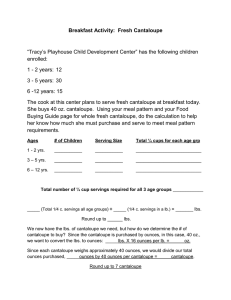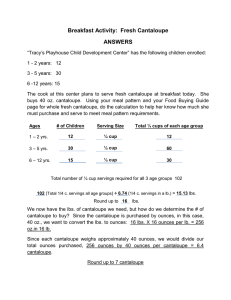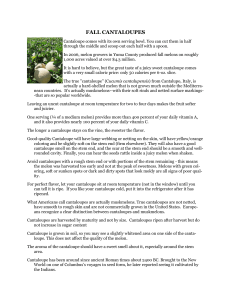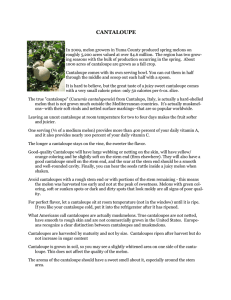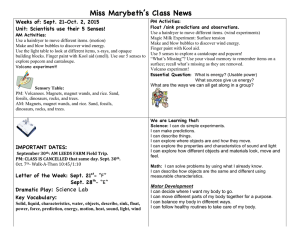Cantaloupe
advertisement
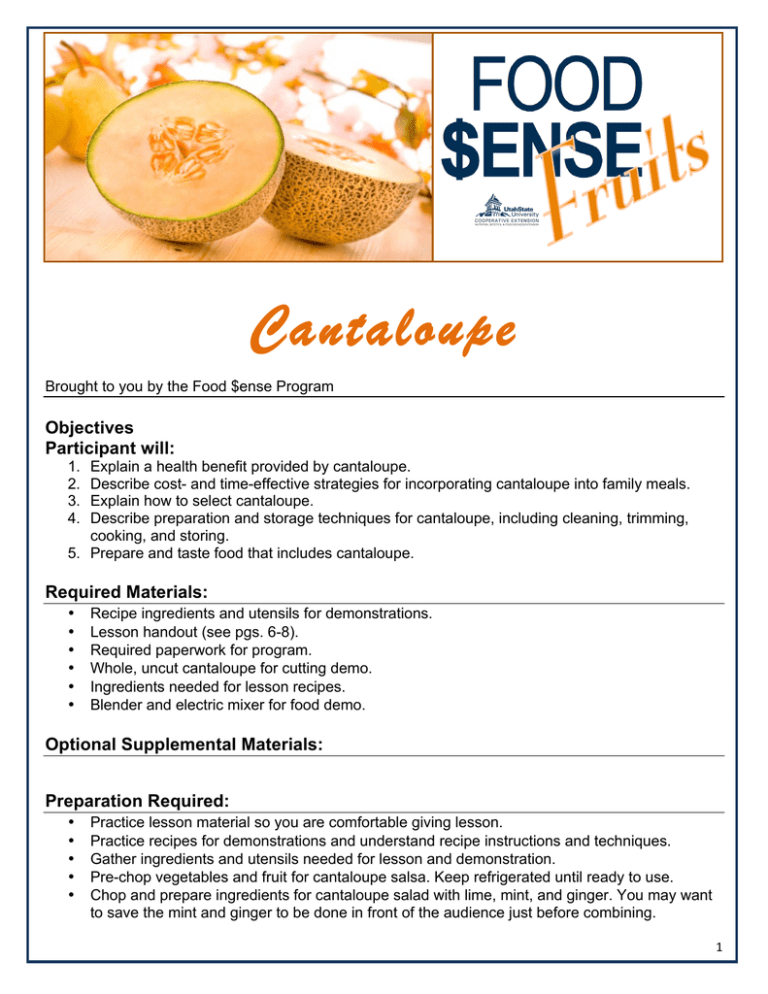
Cantaloupe Brought to you by the Food $ense Program Objectives Participant will: 1. 2. 3. 4. Explain a health benefit provided by cantaloupe. Describe cost- and time-effective strategies for incorporating cantaloupe into family meals. Explain how to select cantaloupe. Describe preparation and storage techniques for cantaloupe, including cleaning, trimming, cooking, and storing. 5. Prepare and taste food that includes cantaloupe. Required Materials: • • • • • • Recipe ingredients and utensils for demonstrations. Lesson handout (see pgs. 6-8). Required paperwork for program. Whole, uncut cantaloupe for cutting demo. Ingredients needed for lesson recipes. Blender and electric mixer for food demo. Optional Supplemental Materials: Preparation Required: • • • • • Practice lesson material so you are comfortable giving lesson. Practice recipes for demonstrations and understand recipe instructions and techniques. Gather ingredients and utensils needed for lesson and demonstration. Pre-chop vegetables and fruit for cantaloupe salsa. Keep refrigerated until ready to use. Chop and prepare ingredients for cantaloupe salad with lime, mint, and ginger. You may want to save the mint and ginger to be done in front of the audience just before combining. 1 • • • Make copies of cantaloupe nutrient worksheet. Make copies of handouts – enough for all class participants. Make copies of paperwork required by program. LESSON PLAN Introduction: Time: 2-3 minutes • Welcome the class and thank them for making time to come. • Briefly introduce yourself and the program. • When it comes to summertime, there is nothing quite as delightful as a refreshing slice of melon! • Melons come in many shapes, sizes and varieties but the most well known melons are cantaloupe, watermelon, and honeydew. • Ask the class: Do any of you enjoy eating melons in the summer? What are your favorite melons? • Today we will be talking about the melon cantaloupe. • Cantaloupe originated in India and Africa where it was known as a muskmelon. It was named this due to the fruits’ “musky” smell. • The “muskmelon” took on the name of “cantaloupe” when it was grown in Italy in the papal (Pope or Roman Catholic church) gardens of the town of Cantalupo. • Cantaloupe was brought to the United States by Christopher Columbus. • Today, California, Arizona, and Texas grow the majority of the cantaloupe crop in the USA. Objective 1: Explain a health benefit provided by cantaloupe. Time: 5 minutes • Cantaloupe is a great tasting fruit that is full of nutritional value. • Cantaloupe is high in potassium and vitamins A and C. • Cantaloupe is also a good source of folate. • Activity: To see if you can identify what these vitamins help with in your body I am going to hand out a worksheet where you can try and match the vitamin to the benefit it provides for you. If you don’t know the answers that is o.k. we will talk about them in a few minutes. Just give it your best guess. • Handout cantaloupe fact worksheet. Let the class take a few minutes to try and match the answers. • Answer Key: o Vitamin A: B, H o Vitamin C: A, C, F,H o Potassium: D, G o Folate: E • Vitamin A helps keep our eyes and skin healthy. It is also known as the “anti-infective” vitamin, because it is needed for the normal function of the immune system. • Vitamin C is an antioxidant. It helps to regenerate Vitamin E so that it can be used again as an antioxidant in the body. Antioxidants help to get rid of harmful cells in the body. • Vitamin C is essential for formation of collagen (connective tissue in your body needed for healthy skin, gums, ligaments and bone) and the normal function of immune system cells. • Potassium is important for fluid balance in our bodies. It also works with calcium to help muscles contract. Potassium is also important as it counteracts the effects of excessive sodium in the diet. 2 • Folate is important during pregnancy because it helps as cells are dividing rapidly, increasing the body’s need for the vitamin. Objective 2: Describe cost- and time-effective strategies for incorporating cantaloupe into family meals. Time: 2-3 minutes • Cantaloupe can be found year round in some supermarkets but are most flavorful and abundant in the months of June through August. • This season is also when the fruit is the least expensive. • Cantaloupes can be a great, cheap snack or side dish. • Ask the class: What meals do you think would go well with cantaloupe? o Use as part of a side salad for a BBQ or summer picnic. o Make into a salsa to use with grilled chicken or fish. o Part of a breakfast fruit parfait or smoothie. o As a desert with ice cream and a chocolate drizzle or made into a sorbet. Objective 3: Explain how to select cantaloupe. Time: 2-3 minutes • Ask the class: What things are important to look for when selecting a cantaloupe? o Do you use any tricks to find a fresh one? • Use these tips when selecting a cantaloupe: • Optional: Show a well selected melon while teaching this section of the lesson and point out the things to look for on the melon itself while you are talking about what to look for. o Pick a cantaloupe that is heavy for its size. o Look for well-shaped fruits with good netting on the outside with a creamy or yellow colored undertone. o Check the melon end for traces of the stem. A mature melon should have no stem left on it, just a distinct indent where the stem was previously attached. o Cantaloupes should have a sweet fruity fragrance. Avoid melons with a strong odor as these are over ripe. o Avoid melons with visible bruises, soft spots, or shriveled, cracked rinds. Objective 4: Describe preparation and storage techniques for cantaloupe, including cleaning, trimming, cooking, and storing. Time: • • • • 10 minutes Cantaloupe is super easy and quick to prepare. All you need is a good knife and a spoon and you are set. Ask the class: What do you think is the most important thing to do before cutting a cantaloupe? o Wash the outside of the cantaloupe with soap and water and dry with paper towels. o Don’t forget to wash your hands as well. o Even though you most likely will not eat the outside of the melon it is very important to wash it thoroughly so that germs from the outside are not transferred to the inside with the knife you use to cut it. o The inside flesh of the cantaloupe is a perfect place for bacteria to grow, so preventing it from getting there is the best approach to preventing food poisoning from happening. Demonstrate how to cut the melon in front of the class. Show two different approaches. Use half of the melon for one approach and half for another. o Approach 1: 3 Cut the melon in half (through the equator, you should have two half circles rather than ovals) and scoop out the seeds with a spoon. Discard. Lay the melon flat, with the cut side on the cutting board and slice on a diagonal into 4-6 wedges. Cut the wedges into smaller pieces starting from the flesh and stopping before cutting into the rind. Slice the small sections off the rind into a bowl. o Approach 2: Cut melon in half (through equator) and scoop out the seeds with a spoon. Slice the very top of the round end off. Lay the melon on the cutting board with the largest cut side down. Start at the top of the melon and slice off the rind from top to bottom in small sections following the shape of the melon with your knife. Rotate the melon and continue until all of the rind is removed. Now that all the rind is removed, cut the flesh of the melon into whatever size you need for your salad or recipe. For a video of this method reference: http://www.fruitsandveggiesmorematters.org/video/VideoCenter.php?Auto=1&sta rt=0&Video=72&SuperSubID=61 Refrigerate cut cantaloupe until ready to use. You can use this cantaloupe for food demos later in the lesson. Ask the class: Does anyone know how long a cut cantaloupe can store? Cut cantaloupe should always be refrigerated. Cut melons will last up to five days in an airtight container in the refrigerator. Uncut cantaloupes can be stored at room temperature for about a week. Cantaloupe is most often eaten raw. The melon does not generally hold up well when baked or cooked by itself, however, it can be added into bread or muffin mixes as a flavoring. Cantaloupe can be frozen for longer storage. To freeze, cut or cube the melon, pack into freezer quality zipper bags and place in freezer. Once cut and prepared cantaloupe can be eaten plain, added to other fruits for a salad, dipped in yogurt, made into a salsa, or served with sherbet for a delightful dessert. • • • • • • Objective 5: Prepare and taste food that includes cantaloupe. Time: 15 minutes • Ask the class: How many of you have tried cantaloupe before? What are your favorite ways to eat it? • If some of these ways are not mentioned, share them with the class. • Plain • In a fruit salad • Dipped in yogurt or other fruit dip • Made into a salsa • In a chicken salad • With cottage cheese and nuts • Place on skewers with shrimp or chicken for the grill • Wrapped in cooked prosciutto or ham slices and drizzled with aged balsamic vinegar • Ball with a melon baller and freeze, pulse in a food processor for an instant sorbet Food Demonstrations: • Cantaloupe is delicious plain, but it is always fun to learn new ways to use the fruit. These recipes we will learn today are simple ways to spruce up your next melon! 4 • • • • • • • • • • First we will try a cantaloupe salsa. There are endless ways to make a salsa using all kinds of fruits and vegetables, even cantaloupe. Demo cantaloupe salsa. Use pre-cut ingredients and show the class how to combine them to make the cantaloupe salsa. This recipe can be eaten with chips, or used as a side with grilled chicken, fish, or steak Cantaloupe goes well with a drizzle of lemon or lime juice. This next recipe uses lime juice as well as a few other herbs to make ordinary cantaloupe a new flavor sensation. This is an easy way to make your next cantaloupe a party favorite. Demo Cantaloupe Salad with Lime, Mint, and Ginger. Cantaloupe can also be added to slushies and smoothies or dipped in a yogurt dip. Demo Cantaloupe Freezie and Fluffy Fruit Dip. As you can see there are many things that you can do with cantaloupe. Ask the class: What are ways you use other fruits that would be easy to substitute or add cantaloupe to the recipe? o In a green salad o In a chicken salad o In a fruit salad o Smoothie Conclusion: Summary Time: • • • • 2-3 minutes Ask the class: Are there any questions? Serve samples Ask the class: What was your favorite cantaloupe recipe? Thank you for attending. References: Fruit of the Month: Melon. CDC: Fruit and Vegetable of the Month. Available at http://www.fruitsandveggiesmatter.gov/month/melon.html. Cantaloupe. Dole Food Company. Available at http://www.dole.com/EatRightLanding/EatRtProductIndex/Fruits/Fresh/FreshFruitsdetails/tabid/529/Default.asp x?contentid=1341. Cantaloupe: Nutrition, Selection, Storage. Produce for Better Health Foundation. Available at http://www.fruitsandveggiesmorematters.org/?page_id=174. Fruit and Veggie Guru Facts on: Cantaloupe. Fruit and Veggie Guru. Available at http://fruitandveggieguru.com/Cantaloupe.html?pccid=7&tabid=70&kw=Cantaloupe. This material was funded by USDA's Supplemental Nutrition Assistance Program. The Supplemental Nutrition Assistance Program provides nutrition assistance to people with low income. It can help you buy nutritious foods for a better diet. To find out more, call 1-800-221-5689 or visit online at http://www.fns.usda.gov/fsp/outreach/coalition/map.htm. In accordance with Federal law and U.S. Department of Agriculture's policy, this institution is prohibited from discriminating on the basis of race, color, national origin, sex, age, religion, political beliefs or disability. To file a complaint of discrimination, write USDA, Director of Civil Rights, Room 326-W, Whitten Building, 1400 Independence Avenue, SW, Washington, D.C. 20250 or call (202) 720-5964 (voice and TDD). USDA is an equal opportunity provider and employer. This institution is an equal opportunity provider and employer. 5 Cantaloupe What is it good for anyway? Match the nutrient to it’s special functions below. Some answers will be used more than once. Write the matching letters under the vitamin. Vitamin A ______________________ (Hint: 2 answers) Vitamin C ______________________ (Hint: 4 answers) Potassium ________________________________ (Hint: 2 answers) Folate ______________________ (Hint: 1 answer) Functions: A. Helps your body absorb iron. B. Important for eye and skin health. Need this for good night vision. C. Essential for formation of collagen (connective tissue in your body needed for healthy skin, gums, ligaments and bone). D. Important for fluid balance and muscle contraction in the body. E. Important vitamin needed during pregnancy. This is known to reduce birth defects. F. Antioxidant, helps recycle vitamin E so it can be used again as an antioxidant. G. Helps counteract the effects of excess sodium in the diet. H. Helps immune system cells function properly. This material was funded by USDA's Supplemental Nutrition Assistance Program. The Supplemental Nutrition Assistance Program provides nutrition assistance to people with low income. It can help you buy nutritious foods for a better diet. To find out more, call 1-800-221-5689 or visit online at http://www.fns.usda.gov/fsp/outreach/coalition/map.htm. In accordance with Federal law and U.S. Department of Agriculture's policy, this institution is prohibited from discriminating on the basis of race, color, national origin, sex, age, religion, political beliefs or disability. To file a complaint of discrimination, write USDA, Director of Civil Rights, Room 326-W, Whitten Building, 1400 Independence Avenue, SW, Washington, D.C. 20250 or call (202) 720-5964 (voice and TDD). USDA is an equal opportunity provider and employer. This institution is an equal opportunity provider and employer. 6 Cantaloupe Named for the papal gardens of Cantalupo, Italy, cantaloupe is a sweet fruit with endless possibilities! Cantaloupe Salsa Makes 4 servings Source: Produce for Better Health/Del Monte Fresh Produce Co. ½ cantaloupe (large, ripe) ¾ cup red bell pepper, finely diced ¼ cup cilantro, finely chopped 3 tablespoons scallions, finely chopped Juice of 1 lime Pinch of salt and hot pepper flakes Remove seeds and rind from cantaloupe. (You should have approximately ½ pound cantaloupe flesh.) Chop cantaloupe into very small dice. Put in bowl. Add diced red pepper, cilantro, scallions and lime juice. Stir. Add pinch of salt and pepper flakes. Chill. Serve with grilled chicken, fish or steaks. Cantaloupe Salad with Lime, Mint, and Ginger Adapted from a recipe by Charlotte Fekete in Bon Appétit, July 2006 Yield: 4-6 servings 1 cantaloupe, halved, seeded, peeled 3 tablespoons fresh lime juice 3 tablespoons chopped fresh mint or 1 tablespoon dried 2 teaspoons grated lime peel 1 tablespoon sugar 2 ½ teaspoons grated, peeled fresh ginger root 2 teaspoons honey Cut cantaloupe into bite-size cubes and place in a large mixing bowl. Add lime juice, mint, and lime peel. Toss to coat. Mix in sugar, ginger, and honey. Refrigerate until ready to serve. Stir just before serving. 7 Cantaloupe Freezie Recipe from www.cooks.com 1 cup chopped cantaloupe 1 cup orange juice 1 tablespoon lemon juice 2 cups crushed ice 2 tablespoons sugar Combine all ingredients in a blender. Blend until smooth. Fluffy Fruit Dip 8 oz. Fat free whipped topping, frozen, softened slightly 12 oz. Low-fat strawberry flavored yogurt (or other flavor of choice) Place whipped topping and yogurt in a mixing bowl. Cut frozen topping into smaller chunks. Beat together with electric mixer or spoon until smooth consistency. Serve with chunks of cantaloupe or other fruit. This material was funded by USDA's Food Stamp Program. The Food Stamp Program provides nutrition assistance to people with low income. It can help you buy nutritious foods for a better diet. To find out more, call 1-800-221-5689 or visit online at http://www.fns.usda.gov/fsp/outreach/coalition/map.htm. This institution is an equal opportunity provider and employer. 8
